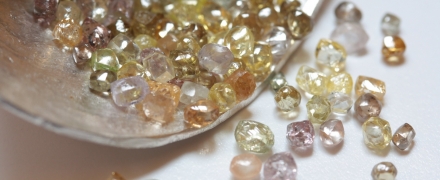open 10 am - 7 pm
laboratory is closed
Nitrogen in diamonds

The generally accepted world classification system for diamonds is based on the presence or absence of nitrogen impurities in them. In accordance with this criterion, two types of diamonds are distinguished: I - nitrogen and II - nitrogen-free (low-nitrogen). Type I is the most common among mined diamonds. It is characterized by the presence of nitrogen as the main impurity, usually in an amount up to 0.1%. In turn, type I is subdivided into two subtypes, a and b, depending on the position of nitrogen in the diamond structure. In type Ia diamonds, two configurations of nitrogen atoms are possible: two nitrogen atoms located in close proximity to each other (the so-called A-defects) and four nitrogen atoms surrounding the vacancy (B-defects). In accordance with this, diamonds IaA and IaB are isolated. If nitrogen atoms form separate nodes in the lattice, replacing carbon, and are isolated from each other, then this type of diamond is called Ib.
Type II diamonds do not have significant nitrogen impurities. The formation of this type of diamond is characterized by very high pressure and a longer life. Type II is divided into types IIa and IIb. The first type (IIa) of diamonds is characterized by the complete or almost complete absence of any impurities. Such stones are quite rare, their amount is only 1-2% of all natural diamonds. The formation of such diamonds occurs at great depths, where pressure and tension can lead to plastic deformations during the growth of the crystal, resulting in imperfections in its structure. This can lead to a yellow, pink, brown, orange and purple hue in diamonds. The second type (IIb) is even rarer than the first, and accounts for only 0.1% of all natural diamonds. In this regard, these diamonds are extremely valuable. Diamonds of this type contain an admixture of boron, the presence of which causes a light blue or gray color and semiconductor properties characteristic of stones of this type.
В геммологической практике бывают весьма увлекательные случаи с диагностикой ювелирных вставок
Но помимо редкости цвета и высокой стоимости таких камней, многие розовые камни выделяются одной замечательной особенностью – они проявляют плеохроизм, то есть в зависимости от положения осмотра камня он может иметь дополнительные оттенки – оранжевый или пурпурный.
Currently, gemstones are produced by two fundamentally different technological methods - the High Pressure - High Temperature method (“HPHT”, High-pressure & High-temperature) and the Chemical Vapor Deposition (“CVD”, Chemical vapor deposition) method. The "HPHT" method is the most tested classical synthesis method, which can be used both carbon deposition on diamond from flux melts and catalytic reactions. In "CVD" synthesis, diamond growth occurs on a seed during carbon deposition mainly from a gaseous medium at relatively low temperatures and pressures.
Jewelry and precious stones are just such a category of goods, when buying which you need to pay attention to many criteria.
Sogdianite is a rather rare mineral and more often it can be found as a collection material (moreover, in systematic collections), and it is extremely rare in jewelry.






